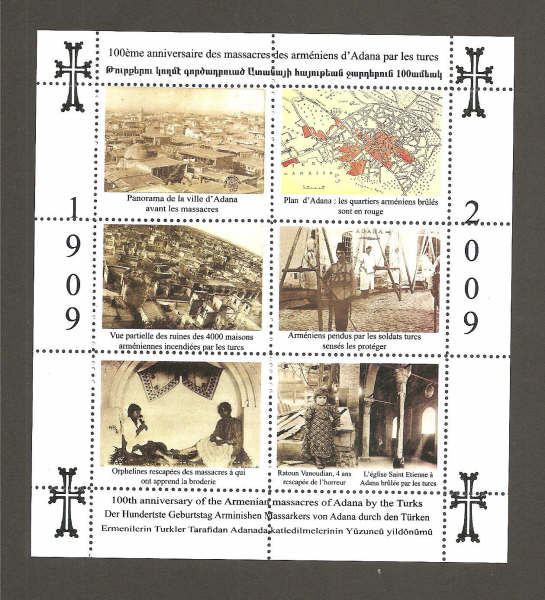Announcement
Collapse
No announcement yet.
1909 : Adana armenian massacre
Collapse
X
-
Re: 1909 : Adana armenian massacre
100 years ago today, 30 000 Armenians from Adana were butchered in the streets of the city.
-----------------------------------------------------------
Massacre of Adana Armenians in 1909 is a classic example of Genocide prelude
01.04.2009 20:27 GMT+04:00 Print version Send to mail
/PanARMENIAN.Net/ Massacre of Adana Armenians in 1909 is a classic example of Genocide prelude (similar example, Kristallnacht in Holocaust chronicles), orientalist and historian Suren Manukyan told a PanARMENIAN.Net reporter.
Adana population was heartened with promises of “Liberty, Equality and Fraternity” proclaimed by the new authorities of Ottoman Empire a year before tragic events. Armenians demanded appointments to governmental offices. An atmosphere of amicability was established between Armenians and Turks of Adana region, the more unexpected was the blow to Adana Armenians. People of Adana and adjusting villages were subjected to all the tortures employed during the Genocide of 1915-23: hatred fomentation with religious mottos of “fighting the unfaithful” and violence towards Christians. The Ottoman government sent in the Army of Young Turks to keep peace, but instead they tolerated the violence or participated in it.
In the aftermath of Adana massacres, the government of Turkey, as well as some Turkish writers and nationalists, tried to deny the pogroms. Young Turks tried to shift the responsibility for massacres upon their political rival Abdul Hamid and even out the number of those killed in the massacre, both massacre victims and perpetrators (362 people were arrested: 149 Muslims and 213 Christians). Thus, the impunity was the major total of Adana massacre. 9 Muslims and 6 Armenians were beheaded on May 28. Beheaded Muslims were common people, none of the notables, yet true perpetrators of disturbances were not made accountable. And the only fault of beheaded Armenians was trying to protect themselves.
“Impunity of perpetrators and inconsistence of the Great Powers created a firm perception of unpunishability of killing an Armenian,” Suren Manukyan emphasized.
The tension erupted into riots on April 1, 1909, which soon escalated into organized violence against the Armenian population of Adana and in several surrounding cities. Reports estimated that the massacres in Adana Province resulted in 30,000 deaths.
Turkish and Armenian revolutionary groups had worked together to secure the restoration of constitutional rule, in 1908. On 31 March (or 13 April, by the Western calendar) a military revolt directed against the Committee of Union and Progress seized Istanbul. While the revolt lasted only ten days, it precipitated a massacre of Armenians in the province of Adana that lasted over a month.
The awakening of Turkish nationalism, and the perception of the Armenians as a separatist, European-controlled entity, also contributed to the violence.
Azerbaboon: 9.000 Google hits and counting!
-
Last edited by armenianweb; 04-08-2009, 10:23 AM.
Comment
-
Re: 1909 : Adana armenian massacre
Remembering the tragedy of Cilicia 100 years later

Yerevan - Official Turkish historiography, when it attempts to deny the fact of the Armenian Genocide, presents three fundamental justifications. First, it was war - and a world war at that - and in that process not only Armenians, but also Turks fell victim. Second, Armenians were organizing volunteer units and were fighting among the ranks of Russian forces against the Ottoman Empire. Third, Armenian revolutionaries sought to carve an independent Armenia out of the Ottoman state.
Though none of these circumstances, even taken at face value, would justify mass murder, what explanation is available for the Armenian massacres in Cilicia in 1909? What war was there in 1909? What volunteer units? And finally, Armenian revolutionaries were cooperating with the Union and Progress Party, which was in power.
The declaration of the Ottoman Constitution in 1908 by the Young Turks and its slogans of freedom, justice, and equality were greeted with joy and hope for the future by the Christians in the Ottoman Empire, especially by the Armenians, who during the reign of Abdülhamit II, and primarily in 1894-96, were subjected to massacres. The massacres in April of 1909 in Cilicia quickly dissipated those hopes.
The Union and Progress Party temporarily lost control just before the first wave of massacres, on April 14-18. But the Unionist forces, sent to quell the massacres, joined in a second wave of killings on April 25-27.
The reasons for the Armenian massacres, according to some researchers are several. Armenians in Cilicia were financially better off than the Turks and Kurds, and resentment was a sentiment the organizers of the massacres were able to exploit. The resentment was enhanced by the fact that after a long history of subjugation, Armenians were being treated as equals in the new, constitutional regime.
Exactly one century has passed since those days, when on the banks of the Mediterranean (where in the Middle Ages, for 300 years the Armenian state of Cilicia flourished) the massacre of the Armenians took place, which are better known as the Adana massacres or by the name the Tragedy of Cilicia. Almost 30,000 Armenians were killed; 7,883 children were orphaned; 4,072 women became widows and close to 30,000 people became homeless. In the end, 32 Armenian churches, 19 schools, 2,923 homes and 593 stores were looted and burned to the ground.
Azerbaboon: 9.000 Google hits and counting!
Comment









Comment